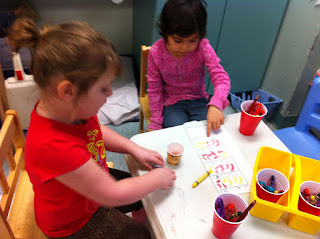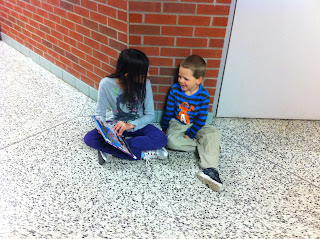Reading Buddies
From time to time, we get together with other classes for reading buddy time. This time is precious - not just because children get one on one time with a storyteller, but also because Kindergarteners start to develop a sense of community with the older students. The last one we had was on Literacy Day.
Wednesday, May 23, 2012
Thursday, April 19, 2012
Measurement Unit

Welcome back! I am finally able to update the website now that my "technological difficulties" are resolved. Technology is always wonderful when it's working! =)
The past few weeks we've had the pleasure of having a Faculty of Education candidate from the local university teaching the Kindergarten children. Ms. Dhaliwal's math focus for teaching has been on measurement. When we talk about measurement in Kindergarten, we are talking about a wide variety of topics including: height, length, the passage of time, surface, mass, using the balance scale and rulers and so much more! We are talking about using standard measurement tools and non standard tools (e.g. "how many pennies long is your hand?".

Ms. Dhaliwal designed a problem solving based task on measurement. The students were tooking to see how many "worms tall" the children are. Children were placed in their House Teams (Which they named accordingly). The task was to measure one person

in their group using non standard measurement (paper worms). Then after performing the task, the groups reported back to the class and finally, we compared the different heights of the children in the class that we measured.
The children did a great job on this task and are working better in groups. This is a challenge in itself. They are learning to work cooperatively with a high degree of focus in order to solve a problem. They are learning both to "share the job" and to make sure that they give everyone a turn.
The students also been using rulers through out the classroom to cut out playdough worms of different lengths for Ms. Dhawali's "fishing trip" coming up and have also used rulers to measure items in the classroom.
At home, you can continue to talk about different terms such as longer/shorter, heavier/lighter. You can also involve your child when using measuring cups for

making food/baking items. As well, have your child hold two items in his/her hands and guess "which one is heavier? lighter?". These types of every day activities make children understand that Math is not a topic in isolation but rather as we say at our school, Math is EVERYWHERE!

Mrs. S.
Sunday, January 29, 2012
Problem Solving


We've been working on our new school wide goal of increasing awareness of problem solving in the classroom. This applies for all children in the school from Kindergarten to Grade Eight. In Kindergarten, problem solving in math means using numbers to answer questions.
Some questions we have worked on are:
-What are different ways to make a number? Such as the number 5. There are many possibilities for these questions and not just one "right answer".
-Another example, If Alyssa has 10 fruits and vegetables all together...How many fruits could she have? How many vegetables?
-So we are working with numbers in a real life context. Children have to use their own thinking or work with a partner or small group to activity solve problems and are engaged in the process.

For Valentine's Day, we had the question: Barbie has 3 valentines. Dora has 10 valentines. Diego has moer than Barbie but less than Dora. How many valentines could Diego have?
Again, this is a thinking question that requires lots of thinking and skills to answer. It requires a "working sense of numbers" and a true understanding versus a "closed" question that has only one right answer.
In our class, we call ourselves "Math Wizards". We are all trying to become Math Wizards. We become a math wizard when we use pictures, numbers and words to solve problems. This will be an ongoing goal for all children in the classroom - to become a math wizard!

Here's some random pictures of our math work:
Mrs. Stefani


Monday, January 23, 2012
Random Creative Fun





We have been working on shapes in the last month - beginning with 2 D shapes and moving towards 3D shapes. This includes a square, diamond, circle, rectangle, square, rhombus, star, heart, hexagon and trapezoid.
For 3D shapes we will be working on learning a sphere, cube, rectangular prism, cone, cylinder and pyramid.
Here's some random shots of building with some 2D and 3D shapes.
Thursday, January 5, 2012
Number Sense

Number sense is something that begins to develop very early.
Young children’s earliest reasoning is likely to be about number situations, and their first mathematical concept will probably be of numbers. Even before children can talk, there is a sense that adding something to a group makes it larger, and taking something away makes it smaller.
Number sense is the ability to count and recognize number, identify the relationships among numbers, and understand how to use them in a variety of ways, such as counting, measuring, or estimating.
It is an inner sense about numbers and reasoning that includes counting aloud, one‐to‐one correspondence, and ordinal numbers.
Some math concepts are so natural that children begin to do them - like sorting and grouping things together (making sets), rote counting, passing out one plate to each child at the table (one‐to‐one correspondence), asking friends “how many” they will be on their next birthday.
Children need exposure to math concepts, to learn new vocabulary or terminology so that math because a natural part of life to them and a promising way of problem solving.

In Kindergarten, we have been playing number games with manipulatives, learning how to add numbers together to make a larger set. We've been exploring combinations of numbers that together make a total. They explored their own quantities with the problem solving of "Mrs. Stefani has a bag of jelly beans. Some are red and some are white. How many jellybeans could Mrs. Stefani have?". The children made their own groupings to problem solve an open ended problem.
Subscribe to:
Comments (Atom)








